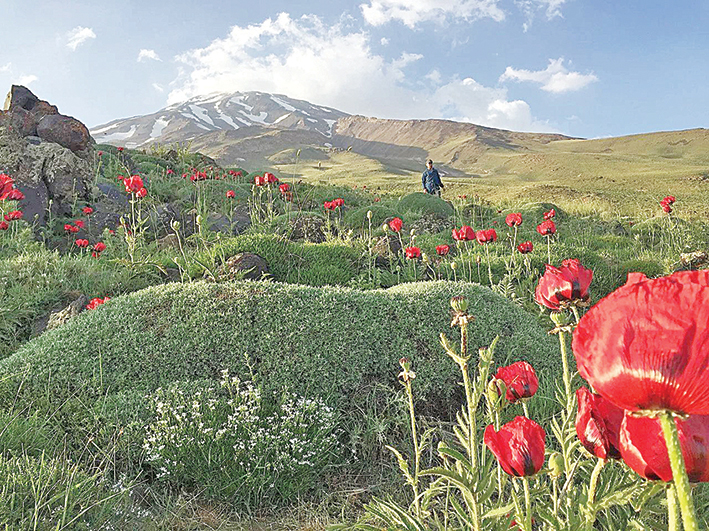 Mountains have always held a place of special reverence in Zoroastrianism, as they are considered spiritual strongholds that represent strength and emanate positive energy. For a decade, our prophet, Asho Zarathushtra, lived on Mount Ushidarena, contemplating the Universal Truth.
Mountains have always held a place of special reverence in Zoroastrianism, as they are considered spiritual strongholds that represent strength and emanate positive energy. For a decade, our prophet, Asho Zarathushtra, lived on Mount Ushidarena, contemplating the Universal Truth.
A prayer pertaining to homage unto mountains, reads: “Az hama gunah patet pashemanum; Vispao garayo asha-khvathrao pouru-khvathrao mazdadhata ashavana ashahe ratavo yazamaide.” (Meaning: “Of all sins, I repent with patet. We praise all holy mountains created by Hormazd (which are) fully comfortable (spacious and with goodness and fulness) full of welfare (spiritual and material) and useful things of righteousness (grow there).”
As per the ‘Vendidad’-19.30, “The soul of pious humdins proceeds by way of Albourz, crossing the ‘Chinwad Bridge’. The reference to Albourz in our holy scriptures, is not to any earthly mountain or mountain range, but a cosmic, spiritual creation of Dadar Hormazd. However, there does exist an earthly mountain range by the name of Albourz, in northern Iran, which runs from Tabriz to the Caspian coast and all along the north to Khorasan, fusing with the Hindukush and Himalayan ranges in Afghanistan and India. The highest peak in the Albourz range is Mount Damavand.
With a high point of 5610.27 meters, Damavand is the highest mountain peak in Iran, located almost in the center of Alborz mountain range. It is higher than all west Asian and European mountain peaks. Damavand peak is situated in Larijan district, 69 kilometers northeast of Tehran. It holds a special place in Persian mythology. Also referred to as the ‘Roof of Iran’, Damavand’s iconic snow-capped cone dominates the landscape of the Alborz Mountain range. Damavand mountain is the epicenter of an earthquake belt – all springs flowing from Damavand Mountain pour into Haraz river. To devout Zoroastrians, Mount Damavand is very sacred.
As per legend, King Faridoon of the Peshdadian dynasty, imprisoned the three-headed dragon – Azhi Dahaka or Zohak (the personification of evil) in chains, to this sacred mountain with his spiritual powers. It is said, by night (when the forces of darkness and evil gain strength) Zohak’s allegorical chains begin to weaken and melt but, at the crack of dawn, when the cock crows ushering the forces of light and purity, the chains, once again, bind the demon, securely.
Another story from Peshdadian times says the evil Afrasiyab attacked Iran but didn’t succeed in conquering her, so he made a treaty with King Minocheher. The condition of the treaty was that the boundaries of King Minocheher’s kingdom would be determined by the distance an arrow (Persian: tir) could be shot. The wise among the people in Iran made a special arrow with great skill and craftsmanship. That tir (arrow) was shot by a skilled and powerful archer named Aresh, from Mount Damavand. Aresh shot the tir eastward, and it soared across the country for twelve hours and fell near the Jehun sea. Afrasiyab then retreated to that place and the territorial boundary between Iran and Turan was thus established. This event is believed to have occurred on the day Tir of the month Tir and a great jashan was held on that day.
Another legend states that Damavand was built from the rubble left over after a massive earthquake flattened the world. These myths highlight the mystic aura surrounding this iconic peak. Historically, inhabitants of the ancient city of Rey are believed to have erected a statue of the goddess Anahita atop Damavand’s summit. The mountain was also considered one of the ‘four pillars’ that held up the sky according to Zoroastrian beliefs.
For modern-day Iranians, Damavand represents the enduring strength and resilience of the nation. Its foundations are buried deep within the Earth’s crust, built up over millennia by countless eruptions of lava and ash. Just as this geological history shaped the proud form of the mountain we see today, so too has Iran’s long history and culture shaped its national identity.
Though an extinct volcano, fumaroles emitting hot gas and sulphurous steam can still be found near Damavand’s summit… reminding us of the powerful geological forces still brewing beneath the surface. Damavand’s eternal snows feeding rivers and water resources also highlight its ongoing role in the environment.
For adventurous hikers and mountaineers, climbing Damavand is a challenging yet rewarding experience. From humid lowland forests to alpine meadows dotted with wildflowers in summer, to windswept ridges and snowy slopes closer to the summit, Damavand showcases the diverse ecosystems found at different elevations. As viewed from the summit on a clear day, you can see the volcanic peaks of the Alborz range, with views of the Caspian Sea shimmering in the distance.
Let us conclude by invoking the eighth verse of the Pazand prayer, dedicated to Mount Damavand – the ‘Afreen-i-haft Ameshaspandan’, which goes: “Hama-zor Daemavand koh ke dravand Bivarasp andar oye basta ested.”
Translated, it means, “Be attuned to Daemavand Koh (mountain) in which is enchained the demon Bivarasp, the demon (with power) of ten thousand horses,” which connotes, that we must attune ourselves with this great spiritual mountain which has the power to bind all forces of evil and keep this world safe from the onslaught of the demon Bivarasp!
May the New Year bless us with the wisdom and protection of this divine mountain! Sal Mubarak!
- તમે ઇન્જેક્શન આપેલા તરબૂચ તો નથી ખાઈ રહ્યા ને? - 27 April2024
- પિતાના હાથની છાપ.. - 27 April2024
- વિસ્પી ખરાડી ફિટ ઈન્ડિયા મૂવમેન્ટનાબ્રાન્ડ એમ્બેસેડર તરીકે નિયુક્ત - 27 April2024
